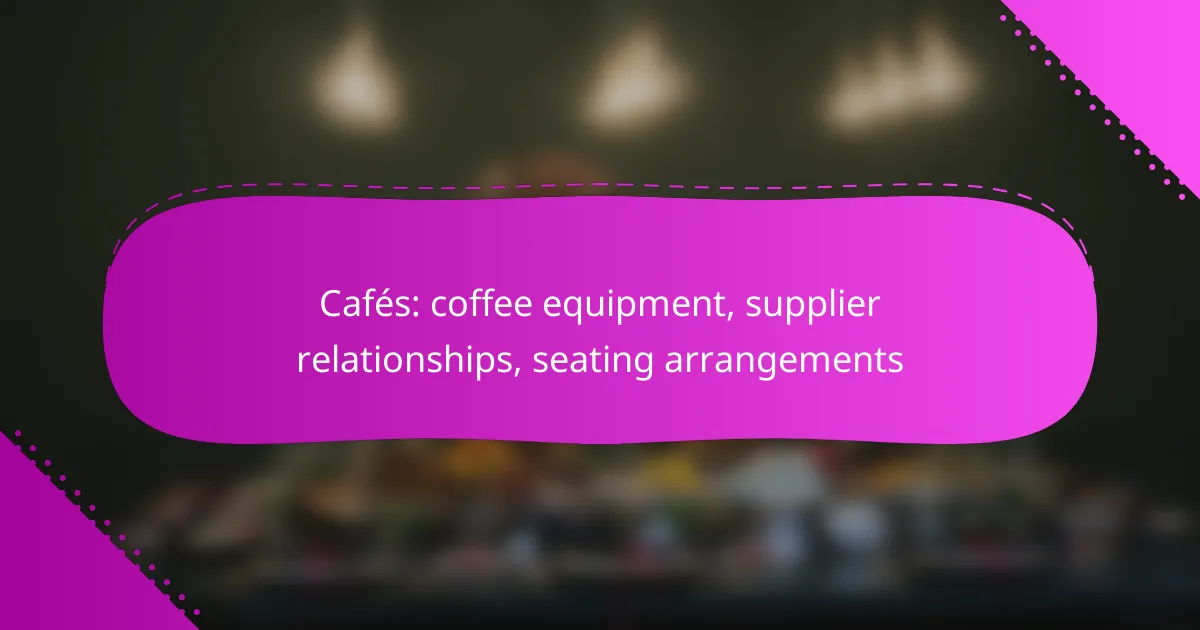Cafés in Canada thrive on the right combination of quality coffee equipment, reliable supplier relationships, and thoughtful seating arrangements. Essential tools like espresso machines and grinders are crucial for crafting exceptional beverages, while strong connections with suppliers ensure consistency and quality. Additionally, strategic seating layouts enhance customer comfort and promote social interaction, ultimately fostering a welcoming atmosphere that encourages repeat visits.

What coffee equipment do cafés need in Canada?
Cafés in Canada require essential coffee equipment to ensure quality beverages and efficient service. Key items include espresso machines, grinders, brewing devices, blenders, and water filtration systems, each playing a vital role in the coffee-making process.
Espresso machines
Espresso machines are critical for any café, as they produce the base for many coffee drinks. When selecting an espresso machine, consider factors such as capacity, ease of use, and maintenance requirements. Machines can range from compact models suitable for small cafés to larger, commercial-grade machines for high-volume settings.
Look for features like dual boilers for simultaneous brewing and steaming, programmable settings for consistency, and quality build materials for durability. Brands like La Marzocco and Nuova Simonelli are popular choices among Canadian café owners.
Grinders
Grinders are essential for achieving the right coffee grind size, which directly affects flavor extraction. Burr grinders are preferred over blade grinders for their consistency and precision. When choosing a grinder, consider the grind settings available and the speed of grinding.
Investing in a high-quality grinder can significantly enhance the taste of your coffee. Popular brands include Baratza and Mazzer, with prices varying based on features and capacity.
Brewing devices
Brewing devices encompass a variety of equipment, including drip coffee makers, pour-over setups, and French presses. Each method offers unique flavor profiles and brewing times, catering to different customer preferences. For instance, pour-over devices like the Chemex provide a clean taste, while French presses yield a fuller body.
Consider offering multiple brewing options to attract a broader clientele. Ensure that your brewing devices are easy to use and maintain, as this can impact service speed and quality.
Blenders
Blenders are vital for cafés that offer specialty drinks such as smoothies or blended coffee beverages. A high-powered blender can handle ice and frozen ingredients effectively, ensuring a smooth texture. Look for blenders with variable speed settings and durable blades.
Brands like Vitamix and Blendtec are renowned for their performance and longevity. Ensure that the blender you choose can handle the volume of orders typical for your café.
Water filtration systems
Water quality significantly impacts the taste of coffee, making water filtration systems essential for cafés. These systems remove impurities and minerals that can alter flavor, ensuring a consistent and high-quality brew. Consider reverse osmosis or carbon filtration systems for optimal results.
Regular maintenance of your water filtration system is crucial to prevent buildup and ensure longevity. Investing in a good filtration system can enhance the overall coffee experience for your customers.

How to choose coffee suppliers for cafés in Canada?
Choosing coffee suppliers for cafés in Canada involves assessing quality, pricing, and reliability to ensure a consistent and satisfying product for customers. Establishing strong relationships with suppliers can enhance your café’s offerings and operational efficiency.
Assess quality and consistency
Quality and consistency are crucial when selecting coffee suppliers. Look for suppliers who provide high-quality beans that meet your café’s flavor profile and standards. Regularly sample their products to ensure that the taste and aroma remain consistent across batches.
Consider certifications such as Fair Trade or Organic, which can indicate quality and ethical sourcing. Establishing a quality benchmark helps maintain your café’s reputation and customer satisfaction.
Evaluate pricing and terms
Pricing is a key factor in choosing coffee suppliers. Compare prices among different suppliers to find competitive rates while ensuring quality is not compromised. Look for suppliers who offer flexible payment terms and bulk pricing discounts, which can significantly impact your bottom line.
Be aware of additional costs such as shipping fees or minimum order requirements. Understanding the total cost of procurement will help you make informed decisions that align with your budget.
Consider local roasters
Partnering with local roasters can provide unique flavors and foster community relationships. Local suppliers often have fresher products and can offer personalized service, which can enhance your café’s appeal.
Support for local businesses can also resonate with customers who value sustainability and community engagement. Explore local roasters’ offerings to find distinctive blends that set your café apart.
Check supplier reliability
Reliability is essential when choosing coffee suppliers. Assess their track record for timely deliveries and consistent product quality. Speak with other café owners to gather insights about their experiences with potential suppliers.
Establish clear communication channels and service expectations to ensure that your supplier can meet your café’s demands. A reliable supplier will help you maintain inventory levels and avoid disruptions in service.

What are the best seating arrangements for cafés?
The best seating arrangements for cafés prioritize customer comfort and social interaction while maximizing space efficiency. A well-thought-out layout can enhance the overall experience, encouraging longer visits and repeat customers.
Comfortable seating options
Comfortable seating is crucial for creating a welcoming atmosphere in cafés. Consider using a mix of chairs, sofas, and benches to cater to different preferences. Upholstered seating can provide extra comfort, while wooden or metal chairs may be easier to maintain.
In addition, incorporating cushions or throws can enhance comfort, especially in colder climates. Aim for seating that allows for easy movement and access, ensuring that customers can settle in without feeling cramped.
Table sizes and layouts
Choosing the right table sizes and layouts is essential for accommodating various group sizes. Small tables for two or four are ideal for casual meetings, while larger communal tables can foster a sense of community. Consider using a mix of table sizes to cater to different customer needs.
Arranging tables in clusters can create intimate spaces, while leaving enough room for movement is crucial. A good rule of thumb is to allow at least 1 meter between tables to ensure comfort and accessibility.
Outdoor seating considerations
Outdoor seating can significantly enhance a café’s appeal, especially in pleasant weather. Ensure that outdoor furniture is weather-resistant and comfortable, using materials like aluminum or treated wood. Shade options, such as umbrellas or awnings, can protect customers from sun or rain.
When planning outdoor seating, consider local regulations regarding permits and space usage. Additionally, positioning outdoor tables near the entrance can attract foot traffic and create a lively atmosphere, but ensure that they do not obstruct pathways.

What are the key factors in café equipment maintenance?
Key factors in café equipment maintenance include regular cleaning, scheduled servicing, and effective management of replacement parts. These practices ensure that equipment operates efficiently, prolongs its lifespan, and maintains the quality of beverages served.
Regular cleaning schedules
Establishing regular cleaning schedules is essential for maintaining café equipment. Daily cleaning of coffee machines, grinders, and brewing devices helps prevent the buildup of coffee oils and residues that can affect flavor and performance.
Consider implementing a cleaning checklist that includes tasks such as descaling machines weekly and wiping down surfaces daily. This not only enhances equipment longevity but also ensures compliance with health regulations.
Scheduled servicing
Scheduled servicing is crucial for keeping café equipment in optimal condition. Regular professional maintenance, typically every six months to a year, can identify potential issues before they become costly repairs.
During servicing, technicians can calibrate machines, check for wear and tear, and replace any worn components. Keeping a service log can help track maintenance history and schedule future appointments effectively.
Replacement parts management
Effective management of replacement parts is vital for minimizing downtime in a café. Maintain an inventory of commonly used parts, such as filters, gaskets, and seals, to ensure quick replacements when needed.
Establish relationships with reliable suppliers to ensure that parts are readily available and consider bulk purchasing for cost savings. Regularly review your inventory to avoid running out of essential components during peak business hours.

How to create a unique café atmosphere?
Creating a unique café atmosphere involves a combination of thoughtful interior design, appropriate lighting, and carefully curated music. Each element contributes to the overall experience, making your café inviting and memorable for customers.
Interior design themes
Choosing an interior design theme is crucial for establishing your café’s identity. Popular themes include industrial, rustic, minimalist, and vintage, each offering a distinct vibe. Consider your target audience and the type of experience you want to provide when selecting a theme.
Incorporate elements such as furniture, wall art, and color schemes that align with your chosen theme. For example, a rustic café might use reclaimed wood tables and warm earth tones, while a minimalist space could feature sleek lines and neutral colors.
Lighting choices
Lighting plays a significant role in setting the mood of your café. A mix of ambient, task, and accent lighting can create a warm and inviting atmosphere. Aim for soft, warm lights to encourage relaxation and conversation.
Consider using pendant lights over tables or wall sconces to enhance the aesthetic. Dimmer switches can also provide flexibility, allowing you to adjust the brightness based on the time of day or the crowd size.
Music and ambiance
Music selection is key to enhancing the ambiance of your café. Choose a playlist that complements your theme and appeals to your clientele. Genres like acoustic, jazz, or indie can create a relaxed environment, while upbeat tracks may energize the space.
Be mindful of volume levels; music should be a background element that adds to the atmosphere without overpowering conversation. Regularly update your playlists to keep the experience fresh for returning customers.

What are the emerging trends in café seating?
Emerging trends in café seating focus on comfort, flexibility, and social interaction. Cafés are increasingly adopting diverse seating arrangements that cater to different customer needs, enhancing the overall experience.
Flexible Seating Arrangements
Flexible seating arrangements allow cafés to adapt to varying customer flows and preferences. Options like movable furniture and modular seating can create intimate spaces or larger communal areas as needed. This adaptability is particularly valuable during peak hours or special events.
Consider incorporating a mix of seating types, such as sofas, benches, and individual chairs, to accommodate different group sizes and social dynamics. This variety not only enhances comfort but also encourages longer visits and repeat customers.
Outdoor and Hybrid Spaces
Outdoor seating has gained popularity, especially in urban areas, as it offers a relaxed atmosphere and fresh air. Cafés are increasingly utilizing patios, balconies, and sidewalk spaces to attract customers looking for an al fresco experience.
Hybrid spaces that blend indoor and outdoor seating can maximize the use of available space. For example, retractable glass walls can create an open environment during pleasant weather while providing shelter when needed.
Community-Centric Designs
Community-centric designs focus on creating a welcoming environment that encourages social interaction. This trend often includes communal tables, shared seating, and spaces designed for events or workshops.
Incorporating local art and cultural elements into the seating area can further enhance the sense of community. This approach not only attracts locals but also creates a unique identity for the café.
Technology Integration
Integrating technology into seating areas is becoming more common, with features like charging stations and Wi-Fi access points. These additions cater to customers who wish to work or study while enjoying their coffee.
Consider using furniture that incorporates technology seamlessly, such as tables with built-in power outlets. This can enhance customer satisfaction and encourage longer stays, ultimately boosting sales.
